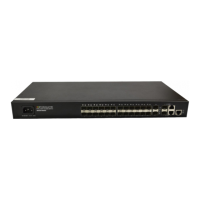STP Configuration
Forward delay: forward delay of the port.
Note:
For the convenience of description, the description and examples below
involve only four parts of a configuration BPDU:
Root bridge ID (in the form of device priority)
Root path cost
Designated bridge ID (in the form of device priority)
Designated port ID (in the form of port name)
1) Specific calculation process of the STP algorithm
Initial state
Upon initialization of a device, each port generates a BPDU with itself as the root bridge, in
which the root path cost is 0, designated bridge ID is the device ID, and the designated port is
the local port.
Selection of the optimum configuration BPDU
Each device sends out its configuration BPDU and receives configuration BPDUs from
other devices.
The process of selecting the optimum configuration BPDU is as follows:
Table 21-1 Selection of the optimum configuration BPDU
Upon receiving a configuration BPDU on a port, the device performs the following
processing:
If the received configuration BPDU has a lower priority than that of the configuration
BPDU generated by the port, the device will discard the received configuration BPDU
without doing any processing on the configuration BPDU of this port.
If the received configuration BPDU has a higher priority than that of the configuration
BPDU generated by the port, the device will replace the content of the configuration
BPDU generated by the port with the content of the received configuration BPDU.
The device compares the configuration BPDUs of all the ports and chooses the
optimum configuration BPDU.
Note:
Principle for configuration BPDU comparison:
The configuration BPDU that has the lowest root bridge ID has the highest
priority.
If all configuration BPDUs have the same root bridge ID, they will be compared
for their root path costs. If the root path cost in a configuration BPDU plus the
path cost corresponding to this port is S, the configuration BPDU with the
smallest S value has the highest priority.
If all configuration BPDUs have the same root path cost, they will be compared
for their designated bridge IDs, then their designated port IDs, and then the IDs
of the ports on which they are received. The smaller the ID, the higher message
priority.

